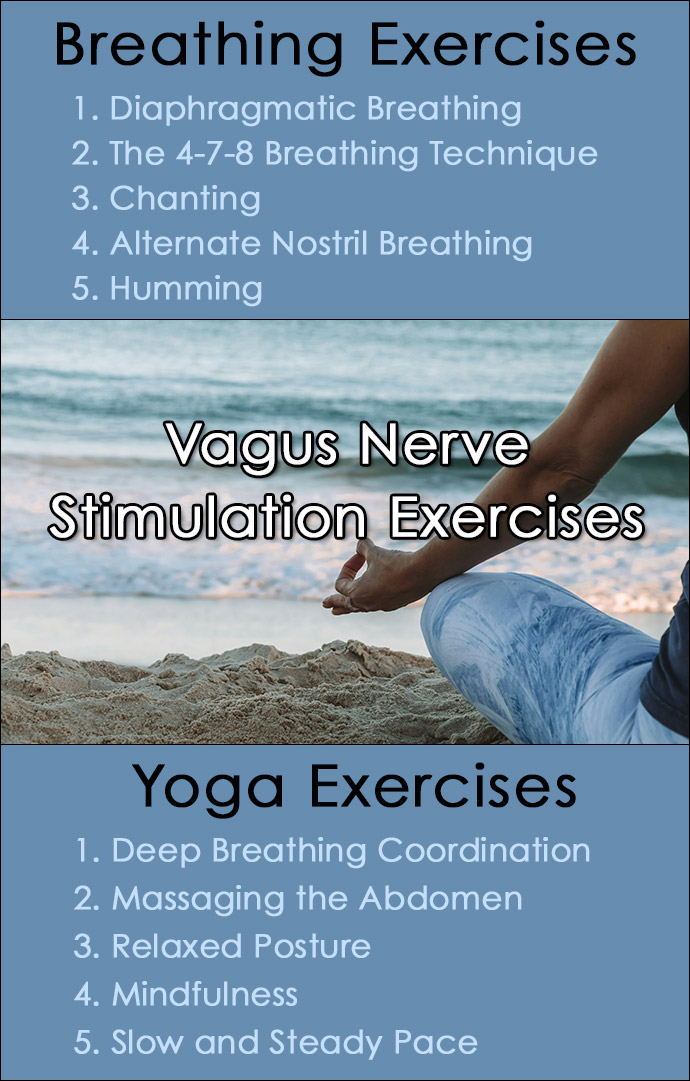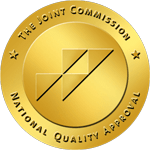Table of Contents
Vagus Nerve Stimulation is a cutting-edge therapy that is beneficial for treating anxiety, stress, depression, and other mood disorders.
Many vagus nerve exercises can be done at home without any special equipment, and VNS implantation is an option for certain individuals who require an artificial means to trigger a response.
Learning how to increase vagal efficiency naturally is helpful for relaxation and improving emotional and mental health.
What is the Vagus Nerve?
The Vagus Nerve is the longest and most complex of the 12 cranial nerves in the brain and plays a role in regulating heartbeat, breathing, digestion, immune function, inflammation, and even mental health.
It originates in the brainstem and extends down into the abdomen and major organs like the heart, lungs, and gut.
The vagal nerve sends vital organ information from the body to the brain to keep food moving through the digestive system and helps regulate inflammation levels and the body’s immune response.
It also closely interacts with the limbic system, which is the emotional center of the brain responsible for mood, motivation, and memory.
How Does The Vagus Nerve Affect Mental Health?
The gut has been called the body’s “second brain” because there is constant communication flowing between it and the brain via the vagus nerve pathways. What affects one, also affects the other.
Stress and various types of anxiety disorders have a negative impact on gut health and the microbiome, which affects vagal tone or the body’s communication efficiency. This is one reason why anxiety and digestive issues often occur together.
Low vagal tone impairs rest-and-digest nervous system activity, and in turn, diminishes mood, motivation, and overall mental well-being.
An unhealthy diet, lack of exercise, and chronic stress are all lifestyle factors that weaken vagal tone. This can lead to improper digestion, fatigue, brain fog, excessive worries, and a low mood.
Decreased vagal function can correlate to conditions like:
- Clinical depression
- Generalized anxiety disorder
- Bipolar disorder
- Obsessive thoughts
- Addiction
A higher vagal efficiency is linked to positive emotions and being able to deal with stress and worry more efficiently.
Vagus nerve stimulation exercises like yoga, deep breathing, and meditation improve relaxation and increase vagal tone.
How Does the Vagus Nerve Interact with the Autonomic Nervous System?
The vagus nerve plays a key role in the Autonomic Nervous System (ANS), which regulates unconscious bodily functions and the body’s stress response.
The Autonomic Nervous System consists of two parts that work together:
1. The Sympathetic Nervous System (SNS) activates the “fight or flight” response during stressful situations to increase heart rate, breathing rate, blood pressure, and other functions.
2. The Parasympathetic Nervous System (PNS) triggers the “rest and digest” response when a person is relaxed by slowing heart rate, promoting digestion, and instilling a sense of calm.
The vagus nerve is critical for activating the parasympathetic “brakes,” so the body returns to functioning in calm manner after a stressful experience has been resolved or is no longer a threat.
Both of these systems work together automatically to keep us safe. However, chronic stress can disrupt vagal nerve function and lead to an abnormal stress-response.
There is a difference between reacting and responding to stress. Fortunately, vagus nerve stimulation can be effective for restoring optimal functioning and promote a stronger vagal tone to reduce stress and anxiety.
How Does Vagus Nerve Stimulation Therapy Work?
There are several different methods of vagus nerve stimulation (VNS) to enhance both physical and mental health.
Artificial VNS can be accomplished using an internal or external vagus nerve stimulator device to activate the vagal nerve.
Other approaches like yoga, breathing techniques, and meditation can be used to naturally stimulate the vagus nerve.
Implanted VNS Device
This involves surgical insertion of a small impulse generator like a pacemaker under the skin on the chest. A wire is then wrapped around the vagus nerve on the neck and a device is programmed to release electrical signals throughout the day.
Non-Invasive Transcutaneous VNS
Transcutaneous VNS Therapy is less invasive and is done externally by placing a handheld device directly on the neck to stimulate the vagus nerve without using any incisions or implants.
Boost Your Vagal Tone Naturally
The VNS therapy methods above are not yet widely available, but there are natural ways to improve vagal function to overcome the root cause of anxiety and stress while boosting mood.
These include:
- Humming or Singing
- Cold Therapy
- Meditation and Mindfulness
- Laughter
- Breathing Techniques
- Yoga
How to Stimulate the Vagus Nerve
Below are some simple exercises known to stimulate the vagus nerve and increase vagal tone.
Vagus Nerve Exercises to Improve Vagal Tone
1. Humming
Humming creates a vibration that activates the vagus nerve. Practice humming for 2 to 3 minutes, several times a day. As you hum, pay attention to the vibration in your throat and chest and notice if it makes you feel more relaxed.
2. Singing
Similar to humming, singing out load releases dopamine that naturally stimulates the vagus nerve. Choose songs that have longer phrases rather than short, choppy lyrics. It’s possible to feel more relaxed after a few minutes of singing out loud.
3. Cold Therapy
Cold showers, splashing cold water on your face, or partial immersion in a cold bath or even a lake can stimulate the vagal nerve. Cold showers increase dopamine and the body’s nerves tend to wake up when exposed to cold.
Start slowly for 30 to 60 seconds and work toward exposure of cold for 2 to 3 minutes. Allow breathing and heartrate to slow down naturally afterward.
4. Meditation and Mindfulness
Many people already know that meditation and mindfulness are popular self care ideas for reducing stress and anxiety. But they have also shown to increase vagal tone within a few weeks of regular practice.
For those who have trouble staying focused on their own, there are apps like Headspace and Calm to help beginners through guided meditations.
Regularly practicing meditation and mindfulness not only helps to lower stress, but it can potentially grow gray matter in brain while also enhancing vagal tone.
5. Laughter
Laughter engages the vagus nerve and has also shown to reduce inflammation. Going to comedy clubs, watching comedies on TV, or playing with kids and pets are all great ways to have a good belly laugh.
6. Breathing Therapy
There are many different types of breathing therapy and they are all simple to do at any time during the day.
Sit upright and breathe deeply from the diaphragm, pushing the belly in and out in slow measured breaths.
Box breathing is another approach that involves inhaling for 4 seconds, holding for 4 seconds, and exhaling for 4 seconds.
7. Yoga
Yoga emphasizes controlled breathing with stretching and is an excellent vagus nerve exercise. It’s important to focus on relaxation rather than intense flows and to prioritize breathing with movement.
Vagus Nerve Stimulation Breathing Exercises
Here are some vagus nerve stimulation breathing exercises to activate the parasympathetic response for better relaxation and stress relief.
1. Diaphragmatic Breathing
Place one hand on your upper chest and the other on your belly. Inhale slowly through your nose and feel your gut expand into your hand without moving your upper hand.
Continue breathing like this for several minutes while focusing on deep, full breaths that make your belly rise and fall.
2. The 4-7-8 Breathing Technique
Sit up straight and relax your face, neck and shoulders. Place the tip of your tongue on the roof of your mouth behind the top front teeth.
Inhale slowly while counting to 4, then hold your breath for a count of 7. Exhale completely through the mouth and make a whooshing sound for 8 seconds. Repeat this breathing pattern 4 or 5 times. The extended exhale activates the vagus nerve.
3. Chanting
Inhale deeply through the nose and exhale through the mouth while chanting “Om” in 3 even, steady tones. Extend the sound for 5 to 10 seconds. Repeat this exercise 5 times as you concentrate on the vibrations in the face and chest.
4. Alternate Nostril Breathing
Use your right thumb to hold your right nostril closed while inhaling slowly through the left nostril for 4 seconds. Pause for 2 seconds while holding the left nostril closed with your finger. Release the right nostril and exhale for 6 seconds. Repeat by alternating nostrils for several minutes.
5. Humming
Start by sitting quietly and taking a deep breath. Completely exhale and on the next breath, hum gently with the lips closed over the exhale for 10 to 15 seconds while feeling the vibrations in the throat and chest.
Repeat this humming exercise 2 to 3 times and allow the body to relax further with each round. The vibrations caused during humming promote vagus nerve stimulation.
Whenever you feel stressed during the day, take a short break to practice these vagus nerve exercises.
The breathing techniques activate the parasympathetic nervous system to offset the fight-or-flight stress response and return to a state of inner calm.
Vagus Nerve Stimulation with Yoga
Yoga is an effective way to stimulate the vagus nerve and boost the parasympathetic nervous system.
How and why yoga stimulates the vagus nerve:
1. Deep Breathing Coordination
Yoga synchronizes movement with controlled breathing patterns. Taking long, deep breaths activates the vagus nerve which connects breathing to relaxing. This helps to lower the heart rate and blood pressure.
2. Massaging the Abdomen
Certain yoga postures provide gentle internal massage that stimulate the vagus nerve where it connects with the digestive system. Twisting poses and forward folds promote healthy digestion and the gut-brain communication of the vagus nerve pathways.
3. Relaxed Posture
Poses like the child’s pose create a soft spine curvature that positively effects vagal tone. Lowering the head below the heart while kneeling encourages vagus nerve activation and promotes the “rest and digest” response.
4. Mindfulness
Yoga encourages concentrating on internal body sensations instead of external stimuli and focusing on the present moment reduces a fight-or-flight sympathetic nerve response. Regular practice can rewire the nervous system to be more calm and less stressed.
5. Slow and Steady Pace
Holding yoga poses for longer lengths at a slow and steady pace while concentrating on breathing reduces arousal of the nervous system by enhancing vagal tone. This is preferred over intense exercise that drives up the heart rate and adrenaline output through sympathetic arousal.
Yoga’s blending of breathing coordination, physically relaxing stretches, mind-body awareness, and slow, methodical pace shifts the nervous system into a calmer vagal tone associated with inner peace and tranquility.
It’s possible to promote healthy vagus nerve stimulation to reduce stress and anxiety and improve mental health in as little as 10 to 20 minutes a day using many of the exercises outlined here.





